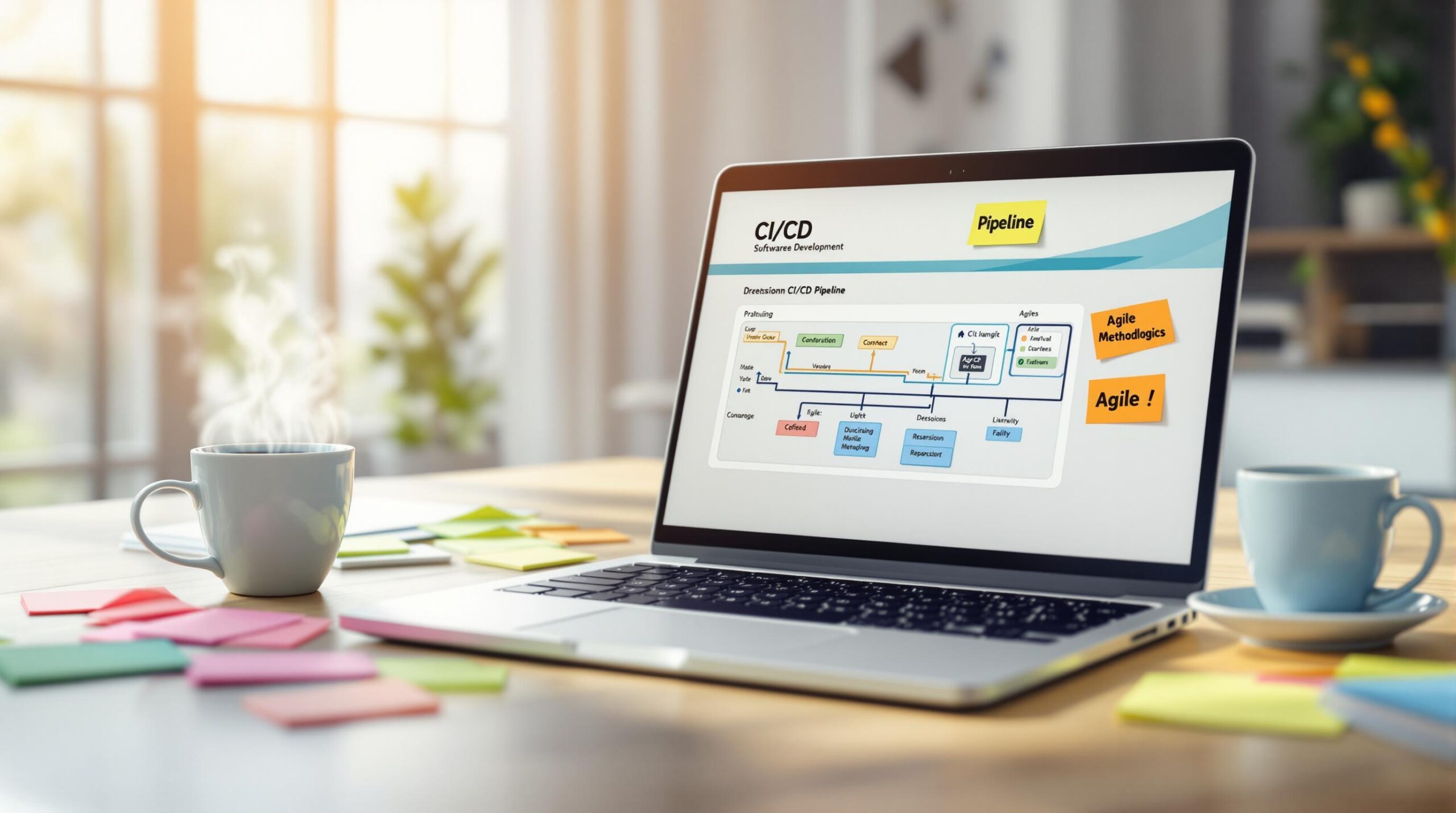Pair programming is a collaborative coding method where two developers work together at one workstation, taking on distinct roles to produce better code and solve problems faster. Here’s what you need to know:
- Why It Works: Reduces code defects by 15%, improves design by up to 50%, and boosts problem-solving accuracy by 15%.
- Core Roles: The Driver writes code, while the Navigator reviews and strategizes. Switching roles every 30 minutes keeps both engaged.
- Methods: Choose between the Standard, Ping-Pong, or Strong-Style approaches based on your team’s needs.
- Tools: Use platforms like Tuple, CoScreen, or Drovio for seamless collaboration.
- Tips for Success:
- Rotate roles regularly.
- Use structured time blocks (e.g., 25 minutes coding, 5 minutes review).
- Communicate clearly and handle disagreements constructively.
Pair programming not only improves code quality but also fosters knowledge sharing and teamwork, making it a valuable practice for modern development teams.
Core Roles in Pair Programming
Pair programming thrives when two key roles are clearly defined and well-executed.
Driver and Navigator Explained
Pair programming revolves around two main roles:
- The Driver handles the keyboard and mouse, actively writing code and focusing on immediate tasks. Their job is to manage the details – syntax, structure, and implementation – while explaining their thought process out loud.
- The Navigator takes a step back, focusing on the broader strategy. They review the code as it’s written, look for potential issues, and think about how the current work fits into the bigger picture, including the overall architecture.
| Role | Primary Responsibilities | Key Focus Areas |
|---|---|---|
| Driver | Writing code, executing tasks | Syntax, immediate problem-solving, structure |
| Navigator | Reviewing, guiding, strategizing | Architecture, catching issues, optimization |
When to Switch Roles
Switching roles regularly keeps both developers mentally sharp and engaged. Most teams aim to switch every 30 minutes to an hour, though shorter intervals (15-30 minutes) can work better for more complex challenges [1][4].
Here are a few tips for smooth transitions:
- Set timers to remind you when to switch.
- Briefly summarize progress during each handoff.
- Take short breaks between shifts to recharge.
In remote setups, these transitions are just as important, and we’ll dive into tools that can help with this later.
For mixed-skill pairs, experienced developers often take on the Navigator role first. This allows them to guide less experienced teammates, who frequently rotate as Drivers to build their skills while keeping productivity high.
Pair Programming Methods
Pair programming thrives on structured collaboration, and these methods help teams work smarter together.
Standard vs Ping-Pong Methods
The Standard Driver-Navigator method and the Ping-Pong approach each suit different needs. In the Standard method, one programmer writes code while the other reviews and plans. It’s great for general development and mentoring. The Ping-Pong method, rooted in Test-Driven Development (TDD), has programmers alternate between writing failing tests and implementing fixes. This makes it ideal for feature development and debugging [2].
| Method | Key Features | Best Used For |
|---|---|---|
| Standard | One codes, one reviews | General development, mentoring |
| Ping-Pong | TDD-based role switching | Feature development, bug fixes |
| Strong-Style | Ideas go through partner’s hands | Knowledge sharing, tough problems |
Strong-style pairing takes collaboration a step further with this principle:
"For an idea to go from your head into the computer, it MUST go through someone else’s hands" [6].
This strategy ensures deeper teamwork and better problem-solving by requiring ideas to be shared and executed collaboratively.
Joint Debugging Steps
Effective debugging with a partner involves these steps:
1. Initial Assessment
The driver explains the code out loud while the navigator listens and challenges assumptions.
2. Systematic Investigation
Break down the problem into smaller, testable parts. Both partners should work together to test and validate potential causes.
3. Resolution and Verification
Collaboratively verify the solution. This approach has been shown to reduce follow-up bugs by about 15% compared to solo debugging [5].
Keeping Teams Focused
Staying productive in pair programming requires structured time management:
| Time Block | Activity | Purpose |
|---|---|---|
| 25 minutes | Focused coding | Core development work |
| 5 minutes | Quick review | Check progress |
| 30 minutes | Role switch | Keep engagement high [2][7] |
These time blocks align with the recommended 30-minute role rotations, helping teams stay sharp and avoid fatigue.
Additional focus tips include:
- Clear communication: Ensure both partners stay aligned on goals.
- Documentation: Keep a record of key decisions during the session.
These practices set the stage for better collaboration and pave the way for tools that enhance teamwork – more on that next.
Software Tools for Pair Programming
Pair programming works best when you combine solid time management practices with tools that make collaboration effortless.
Comparing the Top Tools
Different tools cater to various collaboration needs:
Tuple is a standout for Mac users focused on high-performance tasks, priced at $25 per user per month[6].
| Tool | Key Features | Best Use Case | Monthly Cost |
|---|---|---|---|
| CoScreen | Multi-OS collaboration | Teams using mixed OS | $8/user |
| Tuple | Mac-optimized | Performance-focused | $25/user |
| Drovio | Live code editing | Cross-IDE teams | $8/user |
Teams using these tools reported a 30% boost in productivity in 2024[3]. For budget-conscious teams, CodeTogether‘s Pro plan starts at $4 per month.
These tools are designed to support workflows like role-switching and debugging, as discussed earlier.
IDE Setup Guide
A properly configured IDE ensures smooth transitions between driver and navigator roles, aligning with the time-blocking strategies mentioned earlier.
-
Choose Tools with IDE Integration
Tools with native IDE support are preferred by 78% of developers[6]. For example, Visual Studio Code offers the Live Share extension, which can be installed via the marketplace and authenticated through Microsoft or GitHub[2]. -
Enable Collaborative Features
Set up extensions like Live Share to allow real-time collaboration directly within the IDE. -
Adjust Security Settings
Use features like:- Read-only mode for sensitive files
- Temporary access tokens
- Project-specific sharing controls
These settings help maintain focus on driver/navigator roles.
-
Set Up Communication Tools
Integrated voice and video options ensure seamless communication during sessions.
For teams using IntelliJ-based IDEs, CodeTogether offers tailored integration that keeps native functionality intact while enabling cross-platform collaboration[3].
sbb-itb-f454395
Team Communication Guide
Clear and structured communication is key to making pair programming effective. Research highlights that well-defined communication protocols can significantly boost pair programming’s ability to reduce defects [2]. Combining the right tools with these practices ensures smoother collaboration and better results.
Handling Disagreements
Disagreements are inevitable, but they don’t have to derail progress. Here’s how to handle them effectively:
- Base discussions on data and keep debates short (e.g., 15 minutes for technical issues, 5 minutes for style-related matters).
- Practice active listening and use "I" statements to express viewpoints without assigning blame.
- When necessary, escalate unresolved issues to senior team members for guidance.
Asking the Right Questions
Good questions fuel productive pair programming sessions. Here are some examples to keep discussions focused and effective:
- "What assumptions are we making about this implementation?"
- "How does this solution fit with our current architecture?"
- "What test cases could potentially fail with this approach?"
In addition, use these types of questions to dig deeper:
- Clarifying questions: "Can you walk me through your thought process?"
- Hypothetical scenarios: "What if we tried a different approach, like X?"
- Reflective prompts: "What lessons can we take from past attempts?"
Visual Communication
Visual tools can bridge gaps in understanding and minimize disruptions, especially in remote settings.
Screen Sharing Tips:
- Use color coding to highlight different parts of the code for better clarity.
- Incorporate collaborative whiteboarding tools to sketch out ideas or processes.
These strategies help replicate the natural flow of in-person teamwork, reducing confusion and keeping everyone on the same page.
Learning Through Pair Programming
Pair programming isn’t just about getting more done in the short term – it helps developers build key skills that are essential for long-term growth. One of the most important takeaways? Strong communication skills, which are a must-have in any software engineering career [1].
KodNest‘s Pair Learning Method

KodNest has a unique approach to pair programming. They use structured coding challenges that gradually increase in complexity. Developers are required to rotate partners, exposing them to different coding styles and perspectives. This system, combined with 30-minute role swaps, keeps the process engaging while speeding up skill development.
By sticking to focused time blocks, KodNest ensures that developers not only learn effectively but also build a solid groundwork for working collaboratively.
From Paired to Solo Coding
Pair programming lays the foundation for seamless transitions to working independently. Here’s how developers can shift from paired work to solo tasks without losing the benefits:
- Transition Plan: Start with an 80/20 split between paired and solo work. This gradual shift helps maintain code quality while boosting individual productivity over time.
- Code Review Partnerships: Keep the collaborative spirit alive by conducting code reviews with former pair programming partners. This ensures consistency in standards and fosters shared accountability.
- Self-Review Techniques: Use methods like rubber duck debugging (explaining your code out loud to an object) to retain the verbal reasoning and problem-solving habits developed in pair programming.
Summary
Pair programming is an effective way to produce high-quality code while encouraging teamwork. This guide has shown how combining structured approaches with modern tools can amplify its benefits.
While it may seem costlier upfront, the long-term savings from reduced maintenance often justify the investment. Today’s tools make pair programming easier, offering features like real-time editing and built-in communication.
The driver-navigator model, highlighted earlier, is key to successful pair programming. When paired with rotation systems that ensure balanced participation, this method becomes even more effective.
To get the most out of pair programming, focus on these key practices:
| Focus Area | Best Practice |
|---|---|
| Sessions | Keep them to 2–2.5 hour blocks |
| Tools | Use specialized collaboration tools |
| Communication | Emphasize active listening |
Research has shown that paired teams can complete projects 41% faster with 24% higher test success rates compared to solo developers. These findings support the idea that working collaboratively boosts both speed and quality.
For teams just starting with pair programming, it’s important to have a clear strategy. Begin with complex features or critical bugs. By applying the role techniques and communication methods explained earlier, teams can achieve similar results while staying productive and maintaining high code quality.
FAQs
How can we work better together in pair programming?
To improve pair programming, focus on three key areas: clear communication, defined roles, and efficient tools. Regular check-ins, disciplined role rotation, and the right software can make collaboration smoother and more productive.
Clear Communication
Use specific technical terms and schedule regular check-ins to stay aligned. Practice active listening by rephrasing complex ideas and asking for clarification when needed. Tools like diagrams or pseudocode can make tricky concepts easier to understand[1][2].
Defined Roles
Stick to a timer-based rotation system for smooth transitions, as outlined in Core Roles. During handoffs, follow the provided checklist to keep progress on track and ensure clarity between partners[1][2].
Efficient Tools
Make the most of collaboration tools mentioned in the Software Tools section[5]. These platforms allow real-time code sharing and visual communication, mimicking the experience of working side by side.
When disagreements arise:
- Focus on the technical aspects rather than personal preferences.
- Use objective criteria like performance benchmarks or coding standards.
- Follow the escalation process detailed in Handling Disagreements[1][4].





